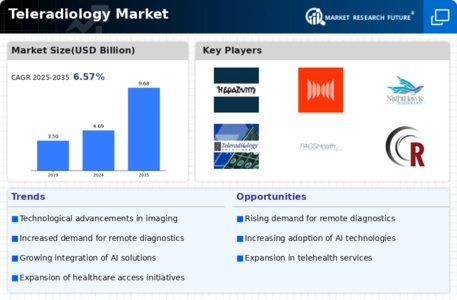Market Growth Projections
The Global Teleradiology Market Industry is poised for substantial growth, with projections indicating a market size of 4.69 USD Billion in 2024 and an anticipated increase to 9.68 USD Billion by 2035. This growth trajectory suggests a robust expansion, driven by various factors including technological advancements, rising healthcare demands, and increasing chronic disease prevalence. The market is expected to grow at a CAGR of 6.81% from 2025 to 2035, indicating a sustained interest in teleradiology solutions. As healthcare systems continue to evolve, the demand for efficient and accessible diagnostic imaging services will likely remain a priority, further propelling the market forward.
Rising Prevalence of Chronic Diseases
The Global Teleradiology Market Industry is being propelled by the rising prevalence of chronic diseases, which necessitate regular imaging for effective management. Conditions such as cardiovascular diseases, cancer, and neurological disorders require continuous monitoring and timely interventions. Teleradiology provides a critical framework for healthcare providers to deliver consistent and accessible imaging services, particularly in remote areas. The increasing burden of these diseases is prompting healthcare systems to adopt teleradiology solutions, thereby enhancing patient outcomes. As the market evolves, it is anticipated that the demand for teleradiology will continue to rise, aligning with the growing need for efficient diagnostic services.
Regulatory Support and Standardization
Regulatory support and standardization are emerging as vital components in the Global Teleradiology Market Industry. Governments and health organizations are increasingly recognizing the importance of establishing guidelines and frameworks that facilitate the safe and effective use of teleradiology services. This regulatory backing not only enhances the credibility of teleradiology solutions but also fosters trust among healthcare providers and patients. As standards are developed, they are likely to encourage wider adoption of teleradiology, ensuring that services meet quality and safety benchmarks. The growing emphasis on regulatory compliance may further stimulate market growth, as stakeholders seek to align with established protocols.
Cost-Effectiveness of Teleradiology Solutions
Cost-effectiveness is a significant driver of the Global Teleradiology Market Industry, as healthcare organizations seek to optimize their operational expenditures. Teleradiology reduces the need for physical infrastructure and allows for the efficient allocation of radiologists' time. By enabling remote consultations, healthcare facilities can minimize overhead costs associated with maintaining in-house radiology departments. This economic advantage is particularly appealing to smaller healthcare providers and rural hospitals, which may struggle with resource limitations. As the market is projected to grow at a CAGR of 6.81% from 2025 to 2035, the financial benefits of teleradiology are likely to play a crucial role in its adoption across various healthcare settings.
Increasing Demand for Remote Healthcare Services
The Global Teleradiology Market Industry is experiencing a notable surge in demand for remote healthcare services. This trend is driven by the growing need for timely and efficient diagnostic imaging, particularly in underserved regions. As healthcare providers seek to enhance patient access to specialist services, teleradiology offers a viable solution. In 2024, the market is projected to reach 4.69 USD Billion, reflecting a shift towards digital health solutions. The convenience of remote consultations and the ability to transmit images quickly are pivotal in this growth, suggesting that the industry may continue to expand as healthcare systems adapt to evolving patient needs.
Technological Advancements in Imaging Techniques
Technological innovations in imaging techniques are significantly influencing the Global Teleradiology Market Industry. Advancements such as artificial intelligence and machine learning are enhancing image analysis and interpretation, leading to improved diagnostic accuracy. These technologies facilitate faster processing times and reduce the likelihood of human error, which is crucial in critical care scenarios. As a result, healthcare providers are increasingly adopting teleradiology solutions to leverage these advancements. The integration of sophisticated imaging modalities is likely to drive market growth, with projections indicating a market size of 9.68 USD Billion by 2035, underscoring the importance of technology in shaping the future of radiology.
















